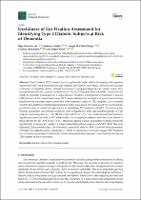| dc.contributor | Vall d'Hebron Barcelona Hospital Campus |
| dc.contributor.author | Simó Servat, Olga |
| dc.contributor.author | Ortiz Zuñiga, Angel Michael |
| dc.contributor.author | Hernández Pascual, Cristina |
| dc.contributor.author | Simó Canonge, Rafael |
| dc.contributor.author | Ciudin Mihai, Andreea |
| dc.date.accessioned | 2019-02-14T10:11:19Z |
| dc.date.available | 2019-02-14T10:11:19Z |
| dc.date.issued | 2019-01-08 |
| dc.identifier.citation | Simó-Servat O, Ciudin A, Ortiz-Zúñiga Á, Hernández C, Simó R. Usefulness of Eye Fixation Assessment for Identifying Type 2 Diabetic Subjects at Risk of Dementia. J Clin Med. 2019;8(1):59. |
| dc.identifier.issn | 2077-0383 |
| dc.identifier.uri | https://hdl.handle.net/11351/3788 |
| dc.description | Demencia; Diabetes; Microperimetría |
| dc.language.iso | eng |
| dc.publisher | MDPI |
| dc.relation.ispartofseries | Journal of Clinical Medicine;8(1) |
| dc.rights | Attribution-NonCommercial-NoDerivatives 4.0 International |
| dc.rights.uri | http://creativecommons.org/licenses/by-nc-nd/4.0/ |
| dc.source | Scientia |
| dc.subject | Diabetis no-insulinodependent |
| dc.subject | Demència - Diagnòstic |
| dc.subject | Ulls - Examen |
| dc.subject.mesh | Dementia |
| dc.subject.mesh | /diagnosis |
| dc.subject.mesh | Diabetes Mellitus, Type 2 |
| dc.subject.mesh | Vision Tests |
| dc.title | Usefulness of Eye Fixation Assessment for Identifying Type 2 Diabetic Subjects at Risk of Dementia |
| dc.type | info:eu-repo/semantics/article |
| dc.identifier.doi | 10.3390/jcm8010059 |
| dc.subject.decs | demencia |
| dc.subject.decs | /diagnóstico |
| dc.subject.decs | diabetes mellitus tipo II |
| dc.subject.decs | pruebas visuales |
| dc.relation.publishversion | https://www.mdpi.com/2077-0383/8/1/59 |
| dc.type.version | info:eu-repo/semantics/publishedVersion |
| dc.audience | Professionals |
| dc.contributor.organismes | Institut Català de la Salut |
| dc.contributor.authoraffiliation | [Simó-Servat O, Ciudin A, Ortiz-Zúñiga Á, Hernández C, Simó R] Grup de recerca en diabetis i metabolisme, Vall d'Hebron Institut de Recerca, Barcelona, Spain. Departament de Medicina, Universitat Autònoma de Barcelona, Barcelona, Spain. [Simó-Servat O, Ciudin A, Hernández C, Simó R] Centro de Investigación Biomédica en Red de Diabetes y Enfermedades Metabólicas Asociadas (CIBERDEM), Instituto Salud Carlos III (ICSIII), Madrid, Spain |
| dc.identifier.pmid | 30626106 |
| dc.identifier.wos | WOS:000457141100058 |
| dc.rights.accessrights | info:eu-repo/semantics/openAccess |

 Área privada
Área privada Contacto
Contacto







